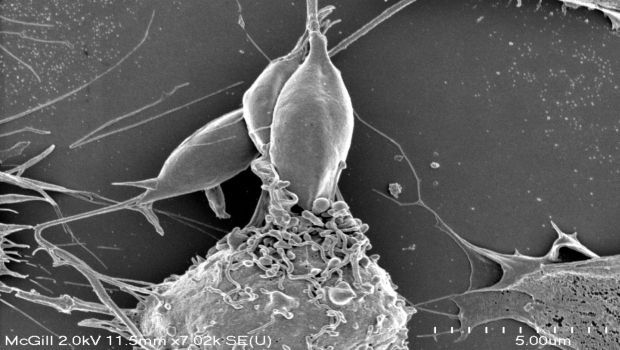Discovery Explains How Leishmania Parasite Boosts Its Infection
A team of international scientists led by Dr. Martin Olivier from the Research Institute of the McGill University Health Centre (RI-MUHC) uncovered an important mechanism behind Leishmania, a deadly parasitic disease transmitted by sandflies that affects over 12 million people worldwide, and with more than 1.3 million new cases reported every year. In a new study published today on the website Cell Reports, researchers described how key molecules known as exosomes, boost the process by which the Leishmania parasite infects humans and other mammals. These findings could lead to the development of new potential vaccine targets and diagnostic tools for Leishmania and other parasitic diseases.


This image shows the parasite Leishmania (top center) being ingested by a macrophage -- type of cell at the front lines of our body's defense against foreign invaders. Image courtesy of Dr. Martin Olivier
A team of international scientists led by Dr. Martin Olivier from the Research Institute of the McGill University Health Centre (RI-MUHC) uncovered an important mechanism behind Leishmania, a deadly parasitic disease transmitted by sandflies that affects more than 12 million people worldwide, and with more than 1.3 million new cases reported every year. In a new study published today on the website Cell Reports, researchers described how key molecules known as exosomes, boost the process by which the Leishmania parasite infects humans and other mammals. These findings could lead to the development of new potential vaccine targets and diagnostic tools for Leishmania and other parasitic diseases.
"Our study reports the first observation that a pathogen within its insect vector can release extracellular vesicles or exosomes that are an integral part of the parasite's infectious life cycle,'' says study's lead author Dr. Olivier, researcher from the Infectious Diseases and Immunity in Global Health Program of the RI-MUHC and a full professor of Medicine at McGill University. "This means that any bacteria and parasites transmitted via insect blood meals could use a similar strategy to extend their successful infection.''
Exosomes are small cell-derived vesicles that are present in many biological fluids, including blood, urine, saliva, etc. They have been the focus of numerous studies due to their involvement in communication between cells, especially immune and tumour cells. Despite the abundant knowledge obtained through studies using exosomes within in vitro experiments, Olivier's team, with colleagues from the National Institutes of Health, is the first to describe, step-by-step, their formation and release in a living organism in relation to a specific infectious agent.
"By using electron microscopy and proteomic analysis, we discovered that the parasite was releasing exosomes within the gut of the female sandflies,'' explains study's first author Dr. Vanessa Diniz Atayde, who is a research associate in Olivier's laboratory. "As the insect took a blood meal from its host, both exosomes and Leishmania were transmitted.''
"We also found that by injecting the parasite with its exosomes in mice models, we were enhancing the pathogenicity of the parasite," adds Olivier. "The inflammatory response, usually caused by an infection, and the number of parasites were increased.''
Leishmania is found in parts of the tropics, subtropics, and southern Europe and is transmitted through the bite of female phlebotomine sandflies. The parasites are injected in the skin and are ingested by immunity cells called macrophages, where they block their immune function and multiply, forming skin lesion and spreading to other tissues in the body depending on Leishmania species involved. This infectious disease can occur in cutaneous forms, which are generally curable, as well as in a more dangerous - and potentially fatal - visceral form. The World Health Organization estimates that 20,000 to 30,000 deaths are caused annually by Leishmania worldwide.
In North America, Leishmania is indigenous to México and Texas, but has begun to expand its range northward. Further expansion to the north may be facilitated by climate change as more habitat becomes suitable for insect vectors and reservoir species for the disease.
"These findings could open the door to the development of new vaccines targeting the exosome components by neutralizing its ability to boost infection,'' says Olivier. "Another interesting aspect of this study is that by studying the exosomes of other biting insects that suck blood, such as mosquitoes or black flies, we could develop anti-allergic therapy to tone-down developed skin inflammation in certain persons upon an insect bite. ''
This study was funded by the Canadian Institutes of Health Research (CIHR). The article Exosome secretion by the parasitic protozoan Leishmania within the sand fly midgut is available online on Cell Reports website.
Source: Research Institute of the McGill University Health Centre
IDEA in Action: A Strategic Approach to Contamination Control
January 14th 2025Adopting IDEA—identify, define, explain, apply—streamlines contamination control. Infection control professionals can mitigate risks through prevention, intervention, and training, ensuring safer health care environments and reducing frequent contamination challenges.
Balancing Freedom and Safety: When Public Health Mandates Are Necessary
January 9th 2025Public health mandates, such as lockdowns, masking, and vaccination, balance liberty and safety, ensuring critical protections during pandemics like COVID-19 while fostering long-term survival through science.
Long-Term Chronicles: Infection Surveillance Guidance in Long-Term Care Facilities
January 8th 2025Antibiotic stewardship in long-term care facilities relies on McGeer and Loeb criteria to guide infection surveillance and appropriate prescribing, ensuring better outcomes for residents and reducing resistance.
Considering Avian Flu: World Health Organization Expert Warns Against Raw Milk
January 6th 2025Drinking raw milk poses risks of disease transmission, especially with H5N1 outbreaks. Expert Richard J. Webby, PhD, advises against raw cow or goat milk consumption due to its unpredictable and significant risks.